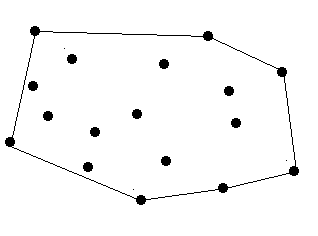Surround the Trees
Time Limit: 2000/1000 MS (Java/Others) Memory Limit: 65536/32768 K (Java/Others)Total Submission(s): 7203 Accepted Submission(s): 2752
Problem Description
There are a lot of trees in an area. A peasant wants to buy a rope to surround all these trees. So at first he must know the minimal required length of the rope. However, he does not know how to calculate it. Can you help him?
There are no more than 100 trees.
The diameter and length of the trees are omitted, which means a tree can be seen as a point. The thickness of the rope is also omitted which means a rope can be seen as a line.

There are no more than 100 trees.
Input
The input contains one or more data sets. At first line of each input data set is number of trees in this data set, it is followed by series of coordinates of the trees. Each coordinate is a positive integer pair, and each integer
is less than 32767. Each pair is separated by blank.
Zero at line for number of trees terminates the input for your program.
Zero at line for number of trees terminates the input for your program.
Output
The minimal length of the rope. The precision should be 10^-2.
Sample Input
9 12 7 24 9 30 5 41 9 80 7 50 87 22 9 45 1 50 7 0
Sample Output
243.06
水平序的Andrew算法:
#include<iostream>
#include<cstring>
#include<cmath>
#include<algorithm>
using namespace std;
struct node
{
double x,y;
}a[105],b[105];
double cmp(node n,node m) //先比較X坐标,在比較Y坐标(从小到大)
{
if(n.x != m.x)
return n.x < m.x;
else
return n.y < m.y;
}
double Cross(node a,node b,node c) //计算叉积大小
{
return (b.x-a.x)*(c.y-a.y)-(c.x-a.x)*(b.y-a.y);
}
double dis(node a,node b) //计算距离
{
return sqrt((a.x-b.x)*(a.x-b.x)+(a.y-b.y)*(a.y-b.y));
}
int CH(node* a,int n,node* b)
{
sort(a,a+n,cmp);
int m=0,i;
for(i=0;i<n;i++) //从左往右,选下边界
{
while(m > 1 && Cross(b[m-2],b[m-1],a[i]) < 0)
m--;
b[m++]=a[i];
}
int k=m;
for(i=n-2;i>=0;i--) //从右往左,选上边界
{
while(m > k && Cross(b[m-2],b[m-1],a[i]) < 0)
m--;
b[m++]=a[i];
}
if(n >1) m--;
return m;
}
int main()
{
int n;
while(cin>>n)
{
if(n==0) break;
memset(a,0,sizeof(a));
memset(b,0,sizeof(b));
int i,j;
for(i=0;i<n;i++)
{
cin>>a[i].x>>a[i].y;
}
// cout<<CH(a,n,b)<<endl; //输出所选点的总数
if(n==1)
cout<<0.00<<endl;
else if(n==2)
printf("%.2lf
",dis(a[0],a[1]));
else
{
int m=CH(a,n,b);
double s=0;
for(i=1;i<m;i++)
s+=dis(b[i-1],b[i]);
s+=dis(b[0],b[m-1]);
printf("%.2lf
",s);
}
// for(i=0;i<CH(a,n,b);i++) //输出所选点的坐标
// cout<<b[i].x<<" "<<b[i].y<<endl;
}
return 0;
}